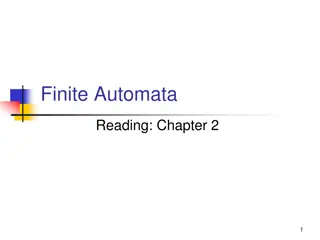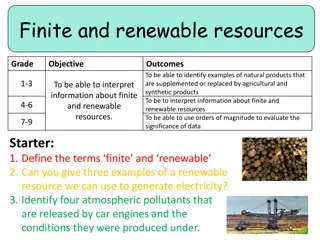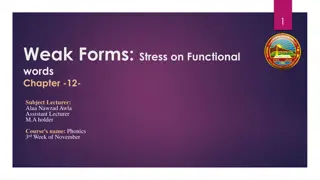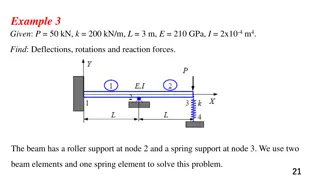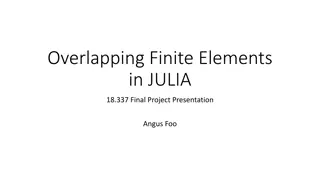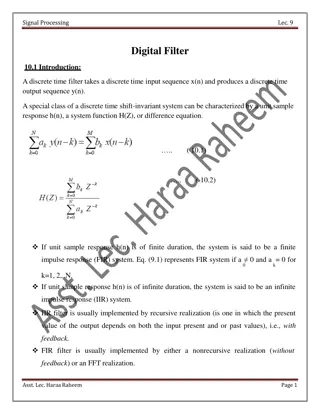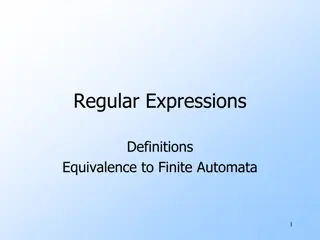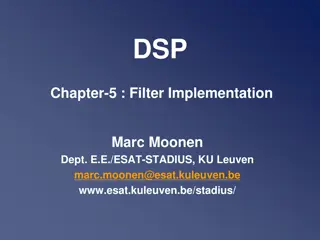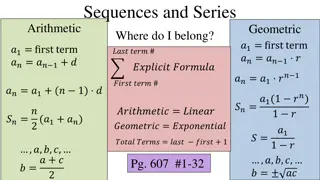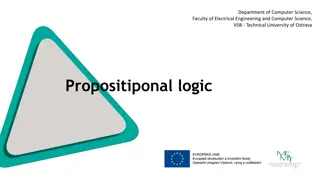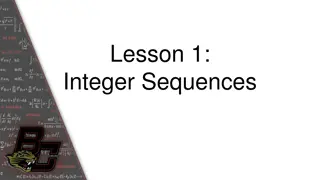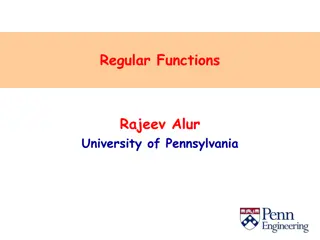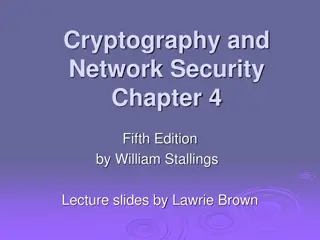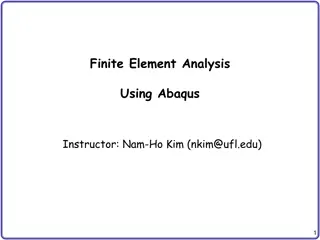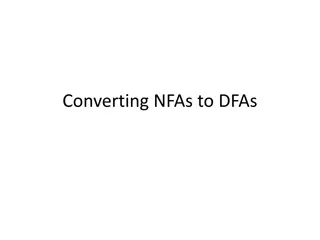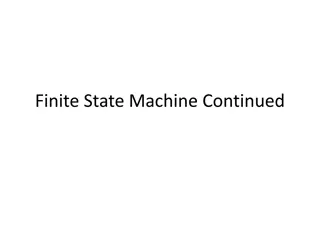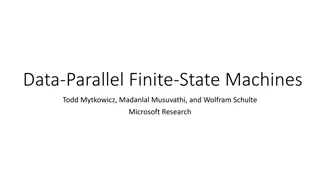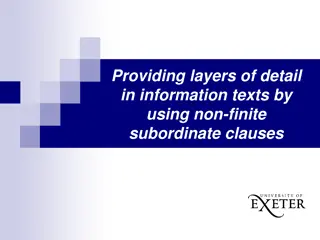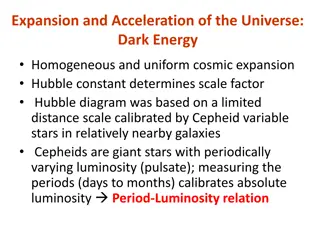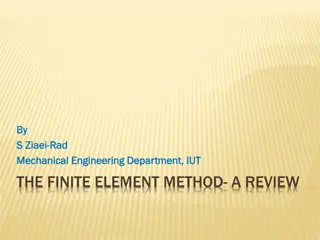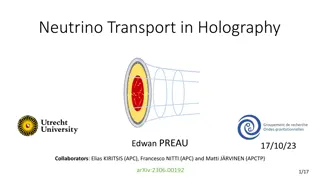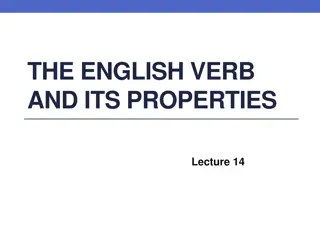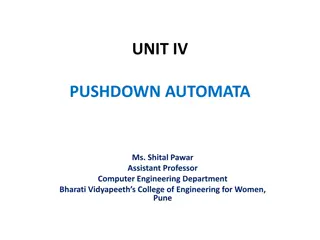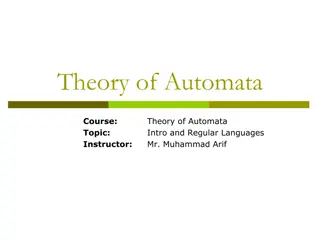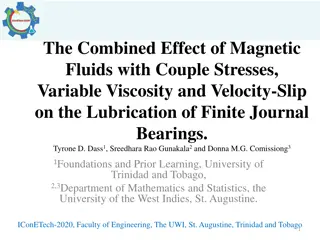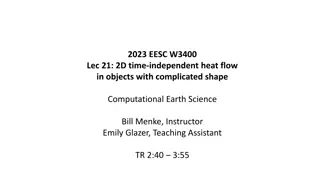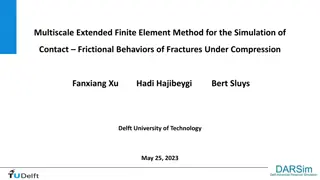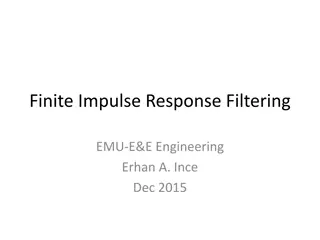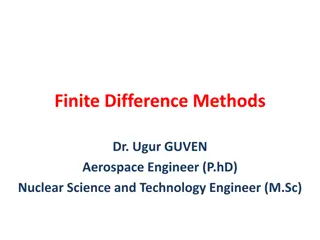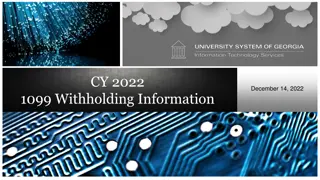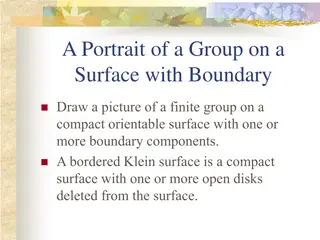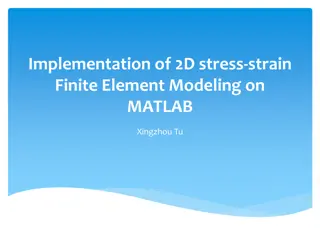Structural Design Using Finite Elements - Introduction to Safety Margins
In the field of structural design using finite elements, understanding safety margins is crucial. Factors of safety, response vs. capacity, sufficiency factors, and excess capacity are explained to ensure structural integrity and performance optimization.
1 views • 36 slides
Introduction to Regular Expressions and Equivalence to Finite Automata
Regular expressions (REs) are used to describe languages by algebra and are equivalent to finite automata. They define regular languages precisely using operations like union, concatenation, and Kleene star. The concatenation of languages combines strings from two languages, while the Kleene star re
9 views • 106 slides
Understanding Deterministic Finite Automata (DFA) in Regular Language Theory
An exploration of Deterministic Finite Automata (DFA) in the context of Regular Languages, covering their definition, functioning, application in recognizing input strings, and building a DFA for a specific language. The Chomsky Hierarchy and the significance of Regular Languages are also briefly di
0 views • 41 slides
Understanding Finite and Renewable Resources in Environmental Science
Explore the concepts of finite and renewable resources, the implications of their usage, examples of natural products replaced by synthetic alternatives, and the importance of sustainability. Delve into the significance of identifying atmospheric pollutants, evaluating data, and fostering responsibl
9 views • 20 slides
Understanding Strong and Weak Forms in English Pronunciation
Exploring the concept of strong and weak forms in English pronunciation, this content discusses the importance of using weak forms in speech, the rules of occurrence of strong forms, and how to recognize the position of weak forms. Examples and explanations illustrate how function words are weakened
1 views • 25 slides
Engineering Beam Analysis using Finite Element Method
Solve beam analysis problems involving deflections, rotations, and reaction forces using the finite element method. The examples provided cover scenarios with roller supports, spring supports, and internal hinges. Learn how to determine displacements, rotations, and element forces in beams of varyin
0 views • 42 slides
Understanding Myhill-Nerode Theorem in Automata Theory
Myhill-Nerode theorem states that three statements are equivalent regarding the properties of a regular language: 1) L is the union of some equivalence classes of a right-invariant equivalence relation of finite index, 2) Equivalence relation RL is defined in a specific way, and 3) RL has finite ind
1 views • 20 slides
Enhancing Finite Element Analysis with Overlapping Finite Elements in Julia
Finite Element Methods (FEM) play a crucial role in solving complex PDEs in various domains. Overlapping Finite Elements in Julia aim to minimize reliance on mesh quality, improving solution accuracy. By leveraging Julia's matrix capabilities and efficient implementations, users can achieve faster c
1 views • 19 slides
Introduction to Digital Filter Design in Signal Processing
Discrete time filters play a crucial role in signal processing, with finite impulse response (FIR) and infinite impulse response (IIR) systems being two key types. FIR filters have finite duration unit sample responses, while IIR filters have infinite duration responses. FIR filters are implemented
1 views • 12 slides
Equivalence of Regular Expressions and Finite Automata
Regular expressions are an algebraic method to describe languages, specifically the regular languages. They are defined recursively based on symbols and operations such as concatenation and closure. Precedence rules and examples are also provided. The equivalence between regular expressions and fini
0 views • 25 slides
Chapter 5: Filter Implementation and Finite Word-Length Problem Overview
This chapter delves into the implementation challenges of digital filters, particularly focusing on the finite word-length problem. It discusses issues such as coefficient quantization, arithmetic operations, quantization noise, statistical analysis, limit cycles, and scaling. Various realizations a
0 views • 32 slides
Exploring Sequences and Series in Mathematics
Delve into the world of sequences and series, understanding the concepts of arithmetic and geometric progressions. Learn to identify finite and infinite sequences, explore various patterns, and model them mathematically. From arithmetic to geometric, finite to infinite, this content offers a compreh
0 views • 52 slides
Understanding Normal Forms in Propositional Logic
Explore the concept of normal forms in propositional logic, where each formula has a unique truth-value function. Learn about equivalence of formulas, determining normal forms, and canonic forms like Disjunctive Normal Form (DNF) and Conjunctive Normal Form (CNF). Discover how to find canonic forms
1 views • 22 slides
Understanding Integer Sequences and Terms
Explore the concepts of integer sequences, including infinite and finite sequences, terms of a sequence, and nth term formulas. Learn to classify sequences as finite or infinite and find specific terms in a sequence. Gain a comprehensive understanding of notation and terminology used for describing
3 views • 23 slides
Understanding Finite Automata and Regular Functions in Computer Science
Exploring the concepts of regular functions, languages vs functions, finite-state computation, finite automata with cost labels, finite automata with cost registers, and examples of Cost Register Automata. These topics delve into the theoretical and practical aspects of defining functions and comput
1 views • 46 slides
Understanding Finite and Non-finite Verbs in English Grammar
Explore the concept of finite and non-finite verbs through examples and explanations. Learn to identify different types of verbs, their relationship with subjects and tenses, and how they function in sentences. Enhance your understanding of English grammar with practical insights and tips provided i
0 views • 19 slides
Basic Concepts in Number Theory and Finite Fields for Cryptography
In this presentation, the basic concepts of number theory, including divisors, properties of divisibility, the division algorithm, and the greatest common divisor (GCD), are explored in the context of cryptography and network security. The importance of finite fields in cryptographic operations such
0 views • 38 slides
Finite Element Analysis Using Abaqus: Basics and Methods
Learn about the basics and methods of Finite Element Analysis using Abaqus. Explore topics such as preprocessing, interactive mode, analysis input files, components modeling, FEM modeling, and more. Understand the advantages and disadvantages of using GUI versus Python scripting, and how to create F
0 views • 33 slides
Understanding Finite State Machines in Computing
Discover the world of Finite State Machines (FSMs) in computing through images and explanations. Learn about base elements, software complexity, DFA terminology, high reliability proofs, and practical examples like the Fox Chicken Grain Problem. Dive into FSM specifications and explore Java code gen
0 views • 18 slides
Exploring Finite and Non-Finite Verbs in English Grammar
This content introduces the concept of finite and non-finite verbs in English grammar through examples and explanations. It covers the definitions, identification, and usage of finite and non-finite verbs, with practical examples provided for better understanding. The tips mentioned help in distingu
0 views • 20 slides
Numerical Solution of Eulerian Advection Equation in 1-D Operator Splitting
Application of operator splitting over three directions allows reducing the Eulerian advection equation to 1-D, enabling finite differencing of derivatives while maintaining conservation properties. Various numerical schemes like forward Euler, leapfrog, and linear upstream are discussed, highlighti
0 views • 8 slides
Compiler Data Structures and NFA to DFA Conversion
Compiler data structures play a crucial role in the compilation process, handling lexical analysis to code generation. Understanding the conversion from non-deterministic finite automata (NFA) to deterministic finite automata (DFA) is essential for efficient language processing and optimization.
0 views • 10 slides
Understanding Finite State Machines in Digital Logic Design
Finite state machines play a crucial role in digital logic systems, allowing for the implementation of sequential circuit designs. These machines consist of states and transition functions, determining system behavior based on inputs and current state. The output function generates outputs based on
0 views • 35 slides
Data-Parallel Finite-State Machines: A Breakthrough Approach
This research discusses a new method for breaking data dependencies in data-parallel finite-state machines. It highlights the importance of FSMs in various algorithms and the need for parallel versions in processing large data sets. The study explores breaking data dependences with enumeration and t
0 views • 19 slides
Google Forms - Creating Surveys, Quizzes, and More
In this comprehensive guide, learn how to create surveys, quizzes, set preferences, use different question types, embed videos, add images, collaborate on forms, and create Sheets from form responses in Google Forms. Follow step-by-step instructions to enhance your Google Forms skills and become pro
0 views • 13 slides
Enhancing Information Texts with Non-Finite Subordinate Clauses
Providing layers of detail in information texts involves using non-finite subordinate clauses to establish connections between grammar, meaning, and rhetorical effects. The LEAD principles emphasize linking grammar to writing purposefully, using authentic texts as models, and fostering deep metaling
0 views • 8 slides
Understanding the Expansion and Acceleration of the Universe
The expansion and acceleration of the universe, driven by dark energy, is characterized by a homogeneous and uniform cosmic expansion. The Hubble constant, determined by the scale factor, plays a key role. The Hubble diagram, based on Cepheid variable stars in nearby galaxies, uses their varying lum
0 views • 10 slides
An Overview of Finite Element Method in Mechanical Engineering
Finite Element Method (FEM) in mechanical engineering is a powerful numerical technique involving dividing a domain into finite elements, establishing relations between variables, and assembling elements to analyze a system. This method is fundamental for solving one-dimensional problems and approxi
0 views • 63 slides
Neutrino Transport in Holography Research Study
This research study delves into the realm of neutrino transport in holography, focusing on the interaction of neutrinos with dense QCD matter in the core. Motivations, formalisms, holographic set-up, and the holographic correspondence are explored using a toy model of quark matter in 4SYM and utiliz
0 views • 32 slides
Understanding Properties of the English Verb
The English verb plays a central role in expressing predicative functions in sentences, connecting the situation with reality. It encompasses finite and non-finite forms, such as simple, expanded, stress-replacive, and phrasal verbs. Verbs are categorized as notional or functional, actional or stata
0 views • 19 slides
Understanding Pushdown Automata (PDA) in Computer Engineering
Pushdown Automata (PDA) is a powerful computational model that extends the capabilities of Finite Automata (FA) by incorporating a stack memory. PDAs can accept languages that FA cannot, making them essential in theoretical computer science. They consist of components like input tape, finite control
0 views • 59 slides
Theory of Automata: Introduction and Regular Languages Overview
This course delves into the fundamentals of Theory of Automata, exploring topics such as regular languages, finite state models, grammars, Turing machines, and more. Instructor Mr. Muhammad Arif guides students through essential concepts like finite automata, pumping lemma, decidability, and Chomsky
0 views • 95 slides
Combined Effect of Magnetic Fluids and Variable Viscosity on Lubrication of Finite Journal Bearings
Study investigating the impact of magnetic fluids, couple stresses, variable viscosity, and velocity slip on the lubrication of finite journal bearings. The research focuses on pressure distribution, load-carrying capacity, and frictional coefficient in the context of tribology.
0 views • 19 slides
Computational Earth Science: Solving Heat Flow in Objects with Complex Shapes Using Finite Difference Method
Explore projects involving the Finite Difference Method for solving static heat conduction problems, also known as the Poisson Equation. Topics include testing boundary conditions, symmetry of solutions, point sources, dipoles, and more. Gain insights into changing boundary conditions and understand
0 views • 20 slides
Multiscale Extended Finite Element Method for Fracture Contact Simulation
Simulation of contact frictional behaviors of fractures under compression using the Multiscale Extended Finite Element Method (XFEM). The method involves solving governing equations, incorporating additional degrees of freedom, and employing penalty methods. MS-XFEM enhances computational efficiency
0 views • 13 slides
Understanding Finite Impulse Response Filtering in Digital Signal Processing
Explore the concepts of Finite Impulse Response (FIR) filtering in digital signal processing, including filter specifications for low-pass, high-pass, band-pass, and band-stop filters. Learn about frequency normalization, specifications for different filter types, and the transfer function of FIR fi
0 views • 26 slides
Overview of Finite Difference Methods in Computational Fluid Dynamics
Discretization of equations is crucial in CFD, and Finite Difference Methods play a key role. Utilizing Taylor series, forward differences, rearward differences, and central differences, these methods transform partial differential equations into solvable algebraic forms. Understanding these techniq
0 views • 32 slides
Changes in 1099 Withholding Forms for CY2022
Explore the latest updates in 1099 withholding forms for CY2022, including changes in IRS forms, PeopleSoft withholding modifications, and additional considerations for withholding processes. Learn about the new requirements and enhancements impacting 1099-MISC and 1099-NEC forms, such as FATCA comp
0 views • 39 slides
Exploring Finite Groups on Compact Surfaces with Boundaries
Illustrating the concept of finite group structures on compact surfaces with boundaries, this presentation showcases transformations, orientations, and color-coding used to represent group elements. By identifying regions in the hyperbolic plane and applying inversions, the images provide insights i
0 views • 28 slides
Finite Element Modeling for Stress-Strain Analysis in 2D Structures
Explore the implementation of 2D stress-strain Finite Element Modeling using MATLAB. Understand the concepts of stress, strain, plane stress conditions, stress-strain relation, Turner Triangle in FEM, linear interpolation, stress and strain vectors, static equilibrium, and stiffness matrix. Learn ho
0 views • 18 slides


